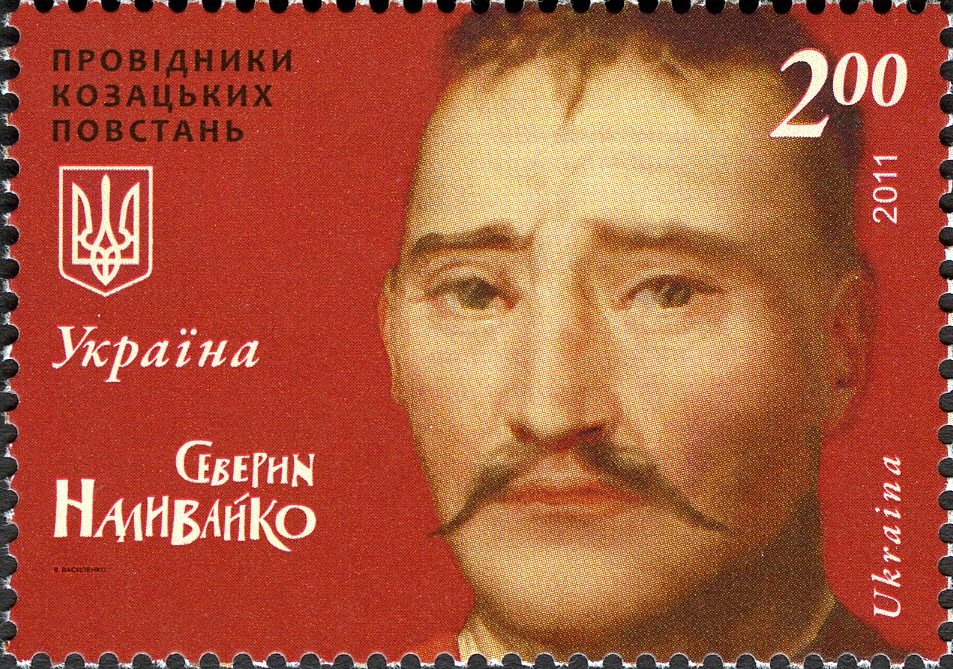Severyn Nalivaiko on:
[Wikipedia]
[Google]
[Amazon]
Severyn (Semeriy) Nalyvaiko (, , in older historiography also ''Semen Nalewajko'', died 21 April 1597) was a leader of the
''Encyclopedia of Ukraine'', vol. 3 (1993).
 Nalivaiko eventually offered peace to the Polish king Sigismund III Vasa, conditioned that the Poles cede the lands between
Nalivaiko eventually offered peace to the Polish king Sigismund III Vasa, conditioned that the Poles cede the lands between
Ukrainian
Ukrainian may refer to:
* Something of, from, or related to Ukraine
* Something relating to Ukrainians, an East Slavic people from Eastern Europe
* Something relating to demographics of Ukraine in terms of demography and population of Ukraine
* So ...
Cossacks
The Cossacks , es, cosaco , et, Kasakad, cazacii , fi, Kasakat, cazacii , french: cosaques , hu, kozákok, cazacii , it, cosacchi , orv, коза́ки, pl, Kozacy , pt, cossacos , ro, cazaci , russian: казаки́ or ...
who became a hero of Ukrainian folklore. He led the failed Nalyvaiko Uprising
The Nalyvaiko Uprising ( pl, powstanie Nalewajki, uk, повстання Наливайка) was a Cossack rebellion against the Polish–Lithuanian Commonwealth. Headed by Severyn Nalyvaiko, it lasted from 1594 to 1596. The second in a series o ...
for which he was tortured and executed in Warsaw. The Decembrist poet Kondraty Ryleyev wrote a poem about him."Nalyvaiko, Severyn"''Encyclopedia of Ukraine'', vol. 3 (1993).
Biography
Nalyvaiko was born in the town of Husiatyn not far from Ternopil into a furrier's family. After the killing of his father by the servants of the magnate Kalinowski he moved with his mother to Ostroh where his elder brother was a seminary student. He later served with the registered Cossacks under Prince Kostiantyn Vasyl Ostrozky in the army of Grand Duchy of Lithuania. In 1593 he fought against the rebellious Zaporozhian Cossacks led by Krzysztof Kosiński during the Kosiński Uprising. He left the service in 1594, and organized a paramilitary unit of unregistered cossacks in the vicinity of Bratslav, and raided several Moldavian and Hungarian towns. The following year, Nalivaiko's Cossacks were joined by many run-away Ukrainian peasants and captured the town of Lutsk where his men massacredPolish nobility
The ''szlachta'' (Polish: endonym, Lithuanian: šlėkta) were the noble estate of the realm in the Kingdom of Poland, the Grand Duchy of Lithuania, and the Polish–Lithuanian Commonwealth who, as a class, had the dominating position in the ...
, Catholic clergy and local Greek-Catholics. From Volhynia Nalivaiko's Cossacks moved into Belarus, where they pillaged Mogilev.
 Nalivaiko eventually offered peace to the Polish king Sigismund III Vasa, conditioned that the Poles cede the lands between
Nalivaiko eventually offered peace to the Polish king Sigismund III Vasa, conditioned that the Poles cede the lands between Southern Buh
, ''Pivdennyi Buh''
, name_etymology =
, image = Sunset S Bug Vinnitsa 2007 G1.jpg
, image_size = 270
, image_caption = Southern Bug River in the vicinity of Vinnytsia, Ukraine
, map = PietinisBu ...
and Dniester rivers south of Bratslav to the Cossacks in exchange for their military service and loyalty to the Polish–Lithuanian Commonwealth. Having refused these terms, the king recalled Stanisław Żółkiewski from Moldavia to quell the Nalivaiko Uprising, which had engulfed most of Polish crown lands in Ukraine and Belarus (that time called Ruthenia
Ruthenia or , uk, Рутенія, translit=Rutenia or uk, Русь, translit=Rus, label=none, pl, Ruś, be, Рутэнія, Русь, russian: Рутения, Русь is an exonym, originally used in Medieval Latin as one of several terms ...
) by 1596.
Nalivaiko joined his forces with the Cossack Hetman Hryhory Loboda
Hryhory Loboda ( ro, Grigore Lobodă; uk, Григорій Лобода, ; pl, Grzegorz Łoboda; born in the Kyiv (Kiev) region — May 1596), was a Kosh Otaman of the Zaporizhian Host (1593–6, with interruptions) of Moldavian descent. In 1594 ...
(Polish: Hryhor Łoboda) but was forced to retreat to the Left-bank Ukraine. In May 1596 the Cossack tabor
Tabor may refer to:
Places
Czech Republic
* Tábor, a town in the South Bohemian Region
** Tábor District, the surrounding district
* Tábor, a village and part of Velké Heraltice in the Moravian-Silesian Region
Israel
* Mount Tabor, Galilee ...
was surrounded by Poles near the town of Lubny. The Cossacks fought for two weeks before running out of food and water. Thereupon they handed over Severyn Nalivaiko to the Poles in exchange for their own lives. After Nalivaiko's surrender there came to unplanned fight between Polish and Cossack troops, which turned into massacre of those who didn't want to surrender. Nalivaiko was brought to Warsaw in a cage and publicly quartered. There were contemporary stories about him being crowned with a white-hot iron crown or boiled alive in a copper cauldron, but they are not verified by factual evidence. Сергій Леп'явко (1994) ''Северин Наливайко // Володарі гетьманської булави: Історичні портрети''. В. А. Смолій.(ed.) — К.: Варта. pp. 53–85.
See also
* List of Ukrainian rulersReferences
{{DEFAULTSORT:Nalivaiko, Severyn 16th-century births 1597 deaths Year of birth unknown People from Husiatyn Hetmans of the Zaporozhian Cossacks Cossack rebels Cossack uprisings People executed by the Polish–Lithuanian Commonwealth Executed Ukrainian people Ukrainian people executed abroad 16th-century executions by Poland People executed by dismemberment